Ijraset Journal For Research in Applied Science and Engineering Technology
- Home / Ijraset
- On This Page
- Abstract
- Introduction
- Conclusion
- References
- Copyright
Automated Water Meter Reading through Image Recognition
Authors: M. Madhuri Latha, P. Sowmya, K. Aruna, U. Sathwika, K. Tejaswini
DOI Link: https://doi.org/10.22214/ijraset.2024.61253
Certificate: View Certificate
Abstract
In this paper, we propose a solution for reading an analog water meter automatically by digitalizing the meter. Since digital water meters are expensive, we retrofit the meter using Raspberry Pi, a camera, and an LED. Though the structure of the analog water meter is simple, consumes less power, and has high durability, it has some disadvantages. Primarily, it requires human effort for reading, which is time-consuming and causes inconvenience to users. To address this challenge, there is a need for an automated system. Thus, the project is implemented using image recognition techniques, specifically Optical Character Recognition (OCR), and Internet of Things (IoT). This method accurately detects the numerical values present on the meter, and this data is transmitted to ThingSpeak, an IoT platform. Overall, this project offers an effective solution for reading water meters and enhance the comfort and convenience of users.
Introduction
I. INTRODUCTION
As the population continues to increase, conserving and using water precisely becomes crucial, and tracking water usage accurately is important. The volume of water passing through the pipe is measured by a mechanical device called water meter. Water meter displays only readings and it is difficult and error-prone to track water usage. Therefore, digitalization can be done to track water usage for resource management, identify usage patterns and trends over time, and enables users to implement water-saving practices. Before delving further into project, it is important for users to understand how to read a water meter reading. Reading of the meter displayed below is 3286.103KL or 3286103L.

From the above reading it is clear that manual readings can prone to error. Therefore, the project focuses on developing an automated water meter reading system to overcome the challenges associated with manual readings. By using image processing techniques particularly OCR, we aim to accurately extract meter readings from images of the water meter. Once the readings are extracted, they are transmitted to ThingSpeak, an IoT platform, for further analysis. This data also allows us to monitor daily water consumption patterns.
II. LITERATURE SURVEY
Water Meter Reading can be done in many methods. Many researchers approached different methods to read water meter readings, some of the research papers are considered below:
A. Improving IoT- based Smart Retrofit Model for Analog Water Meters using DL based Algorithm
The paper introduces a deep learning-based algorithm aimed at enhancing digit detection in IoT-based analog water meters. Trained on a diverse dataset of over 160,000 images from six different water nodes, the algorithm demonstrates robustness and generalization capabilities. A comprehensive comparison with traditional machine learning methods underscores the superior performance of the deep learning approach, particularly in complex environments. While acknowledging the importance of dataset diversity, the paper suggests future enhancements, such as "half-digit" detection, opening avenues for further research and development to improve real-world utility.
B. Digitization of Conventional Water Meters using Automated Number Recognition
The paper presents a prototype for water meter number recognition using OCR techniques, featuring a comprehensive design process covering component selection, electronic circuit, PCB, software coding, and shell case design. The ATmega1284p microcontroller was chosen for its suitability, emphasizing simplicity and cost-effectiveness in circuit design. While the prototype effectively digitized conventional water meters, limitations include the microcontroller's processing power and potential for improved recognition accuracy. Real-world application would require speed optimization, enhanced algorithms, and addressing environmental concerns. Further refinement is necessary to enhance practical viability beyond controlled environments.
III. PROPOSED SYSTEM
The proposed system is Automated water meter reading system. This aims to automate the process of reading wat meters using image recognition technology. The system utilizes hardware components such as water meter, Raspberry Pi 3 Model B+, camera, LED and power supply. Additionally, it uses software components like the Raspbian OS and ThingSpeak platform. The
block diagram of physical components and interconnection is shown below.
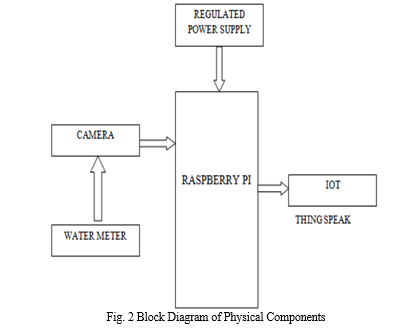
A. Raspberry Pi
The Raspberry Pi functions as the central processing unit and the core of the system, serving as its brain. It executes Python scripts responsible for various tasks such as image capture, preprocessing, and digit recognition.
B. Camera Module
Zeb-Crystal Pro, a USB powered web camera with built-in microphone and LED is used. Using camera frames can be captured and enables users to retrieve images from the camera feed and save them for further analysis.
???????C. Water Meter
Water meter itself serves as the physical source of data. Positioned within the system’s view, the water meter is the focal point for image capture by the camera module. The system’s primary function is to capture images of the water meter using the camera connected to the Raspberry Pi. These images are then processed using image recognition techniques implemented in the Raspbian OS. The system employs python scripts to extract the meter reading from the captured images. The system uploads extracted data to the ThingSpeak platform.
IV. WORKFLOW OF THE SYSTEM
The workflow of the system comprises three main steps: Image Capture and Storage, Image Recognition and Digit Recognition, and Uploading to ThingSpeak. The flowchart provided below illustrates how system operates.
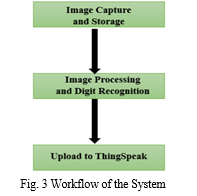
???????A. Image Capture and Storage
Capturing frames of the water meter using a camera connected to the Raspberry Pi and saving these frames for further processing is a primary step.
- Image Capture: This step involves capturing frames of the water meter using a camera connected to the Raspberry Pi.
- Frame Storage: Once frames are captured, they are stored for further processing. The frames are typically saved as image files in a suitable format, such as JPEG, on the Raspberry Pi’s storage device.
???????B. Image Capture and Storage
This part of the system involves processing the captured images to extract digits representing the water meter readings and then recognizing these digits using OCR technique.
- Image Reading: Image reading involves loading an image file using the OpenCV library. The loaded image is stored in the variable ‘image’ and will serve as the input for subsequent processing steps.
- Preprocessing: Convert the image to grayscale and apply binary inversion using thresholding. The original colour image is converted to grayscale. The grayscale image is then threshold using Otsu’s method. This technique automatically determines an optimal threshold for binary segmentation, enhancing the contrast between the digits and the background.
- Digit Extraction: The binary image obtained after thresholding is used to find contours. Images are the bounded contour . Locate contours within the binary image. Each contour representing a digit is extracted from the image.
- Digit Recognition: For each contour, the ROI is extracted from the threshold image. Tesseract OCR is applied to recognize text within the ROI and recognizes the digits extracted from the image.
- Display Reading: The recognized digit is printed to the console. This step provides immediate feedback on the digit detected in the image
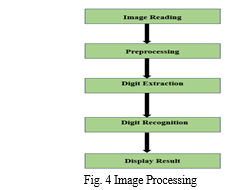
???????C. Upload to ThingSpeak
This part of the system handles the process of uploading the recognized water meter readings to the ThingSpeak platform for storage or further analysis.
- Upload Function: The system defines a function named upload that takes the recognized digit (reading value) as a parameter.
- HTTP Request: Within the upload function, an HTTP request is sent to the ThingSpeak API endpoint, including the recognized digit as a query parameter.
- Error Handling: The function handles potential errors during the upload process and prints appropriate messages indicating whether the upload was successful or not
This detailed elaboration demonstrates how each step in the workflow contributes to the overall process of digit detection using image processing and Tesseract OCR. The combination of image preprocessing, contour detection, and OCR techniques allows for the extraction and recognition of the digits from the input image and the process of uploading the data to ThingSpeak.
V. RESULTS
Automated water meter reading system has been successfully implemented. The implemented automated water meter reading system comprises interconnected hardware components as shown in the below figure.
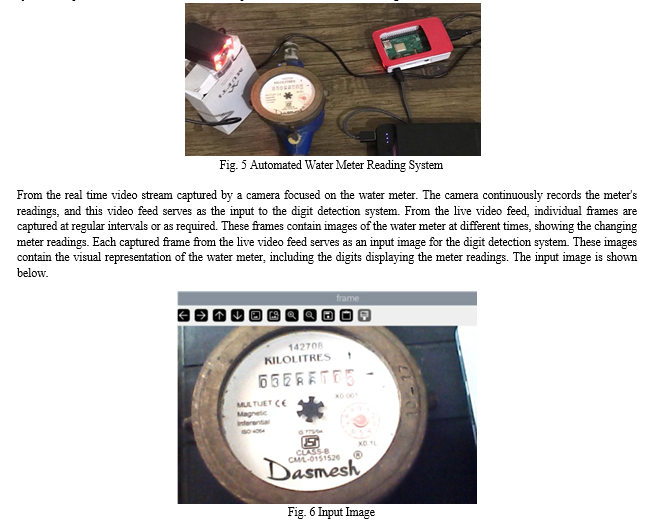
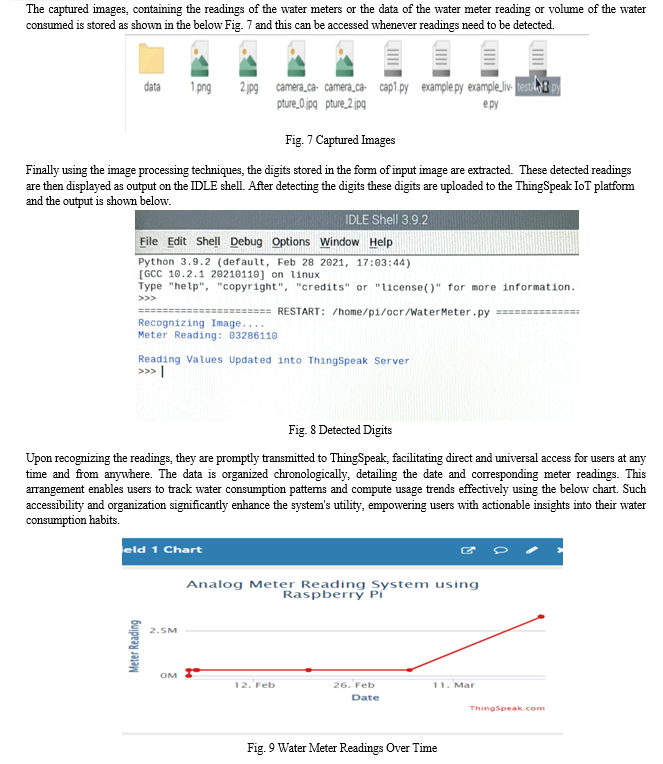
VI. FUTURE SCOPE
The implemented system successfully achieved its primary goals, there are several avenues for future enhancements. These Include:
- Implementation of advanced Image Processing algorithms can be used to improve the accuracy of digit recognition during poor lighting conditions or poor image quality.
- Alerts can be sent in case of unusual patterns or suspected tampering.
- Integrate the automated meter reading system with existing billing systems used by utility providers. This simplifies the billing process by automatically generating.
- Global adoption is likely as benefits become evident, especially in water-stressed regions.
- The integration of deep learning models, such as convolutional neural networks (CNNs), to further enhance the system's ability to accurately detect and interpret digits from water meter images can be done.
- Implementation of edge computing capabilities to perform image processing and digit recognition directly on the device (e.g., Raspberry Pi), reducing reliance on external servers and enabling faster response times can be done.
- Incorporation of a feedback mechanism that allows users to report any discrepancies or issues with the automated readings, enabling continuous improvement and refinement of the system can be done
Conclusion
The project introduces an automated system to tackle the challenges of manual water meter reading. By combining a water meter, LED, Raspberry Pi, and Camera, and utilizing image recognition, particularly Optical Character Recognition (OCR) using Python, the system enables real-time transmission of meter readings. This approach eliminates the need for manual recording and significantly reduces errors. Leveraging cost-effective hardware components like the Raspberry Pi and a camera, our system successfully automates the meter reading process, improves accuracy, and minimizes the risk of tampering. By capturing and processing images of analog water meters, accurately identifying and reading the digits representing water consumption, and seamlessly integrating with IoT platforms for data collection and analysis, our solution offers a practical and efficient approach to modernizing water meter reading systems. By achieving its objectives of automation, accuracy, tamper resistance, and data analysis, our system provides a sustainable solution for enhancing operational efficiency and addressing the shortcomings of manual meter reading processes.
References
[1] Archana R, Boobalan M, Sidharth K. A, Srilekha P, Shyam Kumar M, “Water Quality Detection using Computer Vision and IoT”, International Conference on Power, Energy, Control and Transmission System, December 2022. [2] Chaudhari S, Kumar Lall, Khandelwal, Nilesh N, “Improving IoT-based Smart Retrofit Model for Analog Water using DL based Algorithm”, 9th International Conference on Future Internet of Things and Cloud, August 2022. [3] Dao-Jiun, Wang, Yong-Yi, Fanjiang, Chi-Huang, Hung, Yu-Hsiang, Yeh, Yao Yun Hsiao, Sheng-En, Hsiao, “An Automatic Meter Reading System Using Computer Vision Technology and Hydroelectricity Auxiliary Power Supply”, IEEE 11th Global Conference on Consumer Electronics, October 2022. [4] Fuead Ali, Mohamad Firdaus, Hafifi Saidi, “Water Leakage Detection based on Automatic Meter Reading”, 5th International Conference on Ubiquitous Information Management and Communication, January 2021. [5] Guoxing Jin, KaI bAI, Yixian Zhang, Han He,” A Smart Water Metering System Based on Image Recognition and Narrowband Internet of Things”, Vol 33, International Information and Engineering Technology Association, August 2019, pp. 293-298. [6] Harry Bangkit, Hanif Fakhrurrozi, Ipin Aripin, Slamet Supriadi, Muhamad Sani Aji Rahman, Nizam Ahmad, “Automatic Water Meter Reading Development Based on CNN and Lora WAN”, International Conference on Computer, Control, Informatics and its Application, October 2023 [7] ndrianto and N Jawas, “Image Based Automatic Water Meter Reader”, Volume 953, 2nd International Joint Conference on Science and Technology, September 2017. [8] Khaleel Agail Mohamed, Mark George Munier, Priscilla Philip William, Sami Abbas Nagar, Ali.M.A. Ibrahim, “Enhanced Smart Water Meter Efficiency Based on Mounting Position Selection and Extended Battery Life Time”, International Conference on Computer, Control, Electrical, and Electronics Engineering, August 2018. [9] N. Sushma, H. N. Suresh, J. Mohana Lakshmi, “A Unified Metering System Deployed for Water and Energy Monitoring in Smart City”, Vol 11, October 2023. [10] Xue Jun Li, Yi Gao, “Digitization of Conventional Water Meters using Automated Number Recognition”, IEEE Journal, December 2021. [11] Yulu Ye, Yuhui Yang, Lei Zhu, Jerry Wang, Dongning Rao, “A LoRa-based Low power Smart Water Metering System”, IEEE International Conference on Consumer Electronics and Computer Engineering, 2021.
Copyright
Copyright © 2024 M. Madhuri Latha, P. Sowmya, K. Aruna, U. Sathwika, K. Tejaswini. This is an open access article distributed under the Creative Commons Attribution License, which permits unrestricted use, distribution, and reproduction in any medium, provided the original work is properly cited.

Download Paper
Paper Id : IJRASET61253
Publish Date : 2024-04-29
ISSN : 2321-9653
Publisher Name : IJRASET
DOI Link : Click Here
 Submit Paper Online
Submit Paper Online

